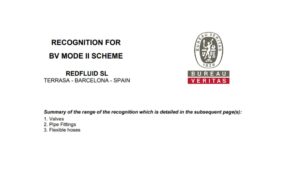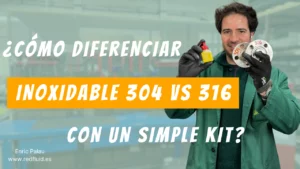
Redfluid obtains BV Mode II recognition from Bureau Veritas
It’s official! Redfluid has been recognized by Bureau Veritas under the BV Mode II scheme — or as we call it in the industry, Company
What is the ATEX certificate?
What is it for?
Do I really need it?
Read on, I’ll answer you.
To understand why or when the ATEX certificate is necessary for valves, you must first be clear about the ATEX certificate.
The ATEX certificate arises from the European directive 94/9/EC. It is applied in the European Union through the new directive 2014/34/EU to ensure that equipment is designed and manufactured by the requirements for operating in potentially explosive atmospheres.
According to the directive, an atmosphere is considered explosive when a mixture of gases, vapors, mists, or dust can experience ignition under certain operating conditions.
Therefore, whenever a valve is installed in a potentially explosive atmosphere, it must be ATEX certified and ideally according to the new directive since directive 94/9/EC ceased to be valid since April 2016.
I leave you a video for you to see our certified valve:
“Zoning” is not a concept found in Directive 2014/34/EU but in the old Directive 1999/92/EC, which deals with the employer’s obligations concerning employees working in hazardous atmospheres. It is not the manufacturer’s responsibility to “zone,” but obviously, this is useful to give an example of the intended area of use.
There are two groups of equipment: Group I, which refers to mines and is very restrictive due to methane gas and highly combustible dust, and Group II, which refers to all other surface industries.
Let me explain the difference between the two groups.
Group I equipment: Intended for use in the subway parts of mines and the parts of the surface installations of such mines, with the danger of firedamp and/or combustible dust.
Group I equipment is divided into two categories, M1 and M2. Almeco does not build or sell fans for these categories.
Group II equipment: Intended for use in explosive atmospheres other than mines or their surface installations.
The ATEX Directive 2014/34/EU divides equipment into groups and categories. To determine the appropriate conformity assessment procedure, the manufacturer must first decide, based on the intended use, to which group and category the product belongs. Annex I defines the criteria for classifying equipment groups and categories.
In the case of group I, the classification depends (among other factors) on whether the product must be de-energized in the event of an explosive atmosphere.
Group II depends on where the product is to be used and whether a potentially explosive atmosphere is continuously present or is likely to occur over a long or short period.
The following table, protection levels, refer to the concept of “zone” as defined by the ATEX workplace. Note that where the group and category are determined equipment properties according to the ATEX “product” Directive 2014/34/EU, the zone is a defined property of the physical location and the likelihood of an explosive atmosphere.
| Level of protection | CAT. 1 | CAT. 2 | Performance of protection | Conditions of operation |
| Very High | M1 | Two independent means of protection or safe even when two faults occur independently of each other. | Equipment remains energized and functioning when an explosive atmosphere is present. | |
| Very High | 1 | Two independent means of protection or safe even when two faults occur independently of each other. | Equipment remains energized and functioning in zones 0, 1, 2 (G) and/or 20, 21, 22 (D). | |
| High | M2 | Suitable for normal operation and severe operating conditions. If applicable also suitable for frequently occurring disturbances or for faults that are normally taken into account. | Equipment is de-energized when an explosive atmosphere is recognized. | |
| High | 2 | Suitable for normal operation and frequently occurring disturbances or equipment where faults are normally taken into account. | Equipment remains energized and functioning in zones 1, 2 (G) and/or 21, 22 (D). | |
| Normal | 3 | Suitable for normal operation. | Equipment remains energized and functioning in zone 2 (G) and/or 22 (D). |
An ATEX needle valve is a valve that offers high precision flow control when working at high pressures within a potentially explosive atmosphere, as defined by ATEX certification.
These valves are generally used for instrumentation and control high-pressure circuits reaching up to approximately 2500 bar. They are typically manufactured from materials compatible with operating fluids, including hydrogen or flammable materials. At Redfluid, we can offer ATEX needle valves according to the new regulation 2014/34/EU, and they are also manufactured according to EN ISO 80079-36:2016 and EN ISO 80079-37:2016 standards. You can view the NEEDLE VALVE CATALOGUE.
An ATEX-certified ball valve allows the flow to be fully closed or opened thanks to the ball-shaped design (normally full bore). These valves can be manual or actuated. It makes it very useful to switch quickly from fully open to fully closed in case of an emergency within the ATEX atmosphere.
In the case of manuals, it is directly ATEX if you buy it in Redfluid, but remember that if you buy them ready to actuate, you must ensure that your electric or pneumatic actuator includes all its components ATEX. For example, the Namur, the limit switch, etc., must be all ATEX. If you wish, we can also supply it all assembled as a whole ATEX equipment. If you need more information about actuators, I recently wrote a blog article about this. You can read it here: ARTICLE ACTUATORS.
These valves can withstand high temperatures up to +450ºC and cryogenic temperatures up to -250ºC while working safely in high-pressure circuits up to 1500 bar.
The ATEX-certified check valve is perhaps one of the essential elements when operating a circuit with potentially explosive fluid. This type of valve is designed so that it allows only one-way flow, which ensures that the fluid does not flow back, creating a potentially dangerous situation.
Moreover, at RedFluid, we have piston check valves that prevent the circuit from unblocking since the fluid will not circulate if it does not overcome the valve’s tare pressure, generally set at 0.5 bar. However, it can be modified upon request. Our check valves can be requested with ATEX 2014/34/EU certification for installation in the most compromised situations. Our check valve catalog is available here: CHECK VALVE CATALOGUE.
ATEX-certified pipe fittings generally offer high flexibility when installing a circuit in areas defined as ATEX, i.e., with a potentially explosive atmosphere. The main characteristic of these fittings is that the manufacturing material can withstand such working conditions and is compatible with the fluid in particular cases such as hydrogen circuits and highly hazardous chemicals without being a reason for ignition.
In conclusion, all ATEX-certified valves and accessories guarantee a safer operation for industries such as oil, petrochemical, and pharmaceutical, among others.
At Redfluid, our valves are certified for equipment group II (table 1), Category 2, and Gas and Dust. That’s why we mark them II 2 G&D.
All ATEX-certified valves are identified with the European Union CE and Ex conformity mark, followed by the indication of the Group, Category, and the indication related to gas (G) and/or dust (D). In some cases, The certification will also add the identification number of the Notified Body involved in the production control or unit testing stage.

Share this post

It’s official! Redfluid has been recognized by Bureau Veritas under the BV Mode II scheme — or as we call it in the industry, Company

A looot of people believe the stainless steel they have in their factories is 316, but they soon realize their materials are not that resistant
One Response
I want to find an actuated ball valve which can meet Atex EX I M2 certification. Do you have any recommendations? Thank you!